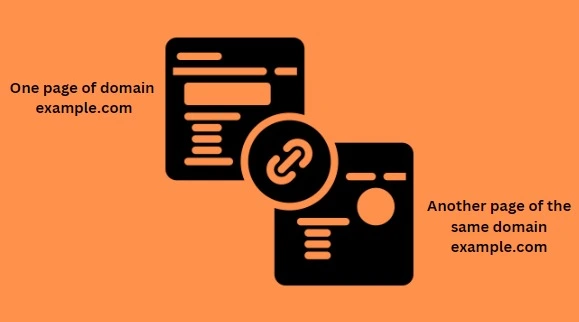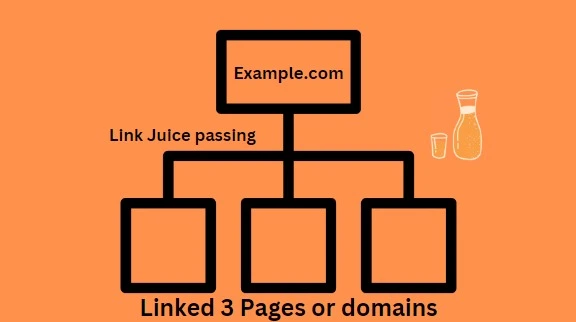Table of Contents
ToggleWhat Is Internal Linking
Internal Linking is when we link one page of our website to another page on the same domain to provide users with relevant, detailed, and more connected content when they click on it.

We should understand how each page is built uniquely and provides different information or services from the other web pages. Here, it becomes important to interlink to help users not get lost and actually get the value they were searching for.
Suppose one of your blog posts is about “Content Marketing Strategies”. Here, you won’t add a link to some blog post where you’ve explained a traveling moment but, something more relatable such as, “SEO Best Practices To Stand Out.”
The motive of internal linking is not to drive traffic from one page to the other but to provide value, and depth in the area your users like to read about and a much better understanding of a topic you were found for.
Internal linking, a traffic-directing method overlooked so many times, is a very powerful process that improves your website’s SEO. You know your website well but for any other being, who’s new to your website, it may feel like a maze and they might feel lost as well.
To help them not get lost and discover more of what they were looking for and stumbled on your website, we use internal linking. To put it more directly, internal linking is like a map that directs and guides users and search engines to the valuable and relevant content you have on your website.
Adding to its features, it’s a great way to boost your website’s authority and visibility.
Why Is Internal Linking Important
Imagine search engines crawling to your website, understanding it, and discovering more relatable content to analyze. How did this happen? Internal Linking.
When the internal linking structure is strong enough to provide value and more value, the pages are found valuable which also improves the indexing of your website. More web pages get indexed to be shown in the search results. Let’s discover more about why internal linking is important for your website!
Improved User Experience (UX)
Every website owner aims to keep their user engaged and increase their stay time on the website. Internal linking helps with both. When a user who wants to read about “Email Marketing For Beginners” visits your webpage and finds it valuable, they’ll surely click on a link that says “Building An Email List”, to get more knowledge on a certain topic.
When you use internal links strategically, pointing to specific and relevant pages, it satisfies their curiosity, increases their stay time, and makes them come back for more.
Increase In Page Authority
Have you ever reached out to some other website to get a backlink because it boosts the authority of your website? What if I saw you can get some page authority through your website as well? But don’t mistake it as an alternative to backlinking as it may affect your website negatively.
When one page is liked by another page that has high authority on the same domain, the link juice gets passed to the targetted page. When the value is passed through links in SEO, it is named link juice. This also increases ranks in SERPs.

Improved Website Structure And Hierarchy
Just like we read earlier, if your website is a maze, internal linking acts as a map. It makes the website structure simple and clear enough to let anyone navigate easily through it.
When links are placed strategically on related pages, search engines understand the hierarchy and importance of the content of your website. It becomes easier for search engines to understand what your website focuses on and categorize pages according to it.
Internal linking plays a great role in making your website clear, focused, and presentable. Its benefits such as improvement in user experience, increased page authority, and clear website structure are just some things to point to and estimate how powerful it actually is.
Best Practices To Follow For Internal Linking
We read what internal linking is and why it’s important. How about we come in some action mode? Just theory never benefits anyone, so, let’s make it practical. Below are some best practices to follow to make it happen!
Tie up the belts and get ready to discover how you can interlink that actually works and gives off more value.
Relevance Is The Top Priority
Force never does any good to anyone. So, don’t ever force links. Relevancy matters when two things connect – such as people. When two strategies find something relevant in them, they become friends. Similarly, connect pages only when they’re related.
For example, if there’s a blog post for Social Media Marketing Tips, it’ll be great to add a link that either discovers new content related to the same topic or provides information in detail for a specific section. Here, you might want to add a blog post that helps with Social Media Content.
Anchor Text Is Important
Where do you place the link when linking internally? Not leaving the URL on a page abandoned right? We always insert links in the text, that text is called anchor text. To make sure that the user gets to know what it is about, use descriptive anchor text relevant to the linked page.
You might not want people to avoid or ignore it, so, do avoid generic terms like “click here” or “Learn more.” Make it descriptive, something like, “Learn more about keyword research”. This signals to the user what the content is about and attracts them.
Link Placement Should Be Well-Thought
Do you ever place a dish to be washed in the already-cleaned dishes drawer? I guess not. So, why do it with the links? There are many moments where it is seen that either links are accumulated in one place, down below the blog posts or aren’t relevant at all.
To avoid getting into this situation as it makes the user experience negative, take up some useful tips –
- Don’t put all the links at the bottom of the content
- Place them strategically through the text where it feels natural and goes with the flow.
- Use them in introductions, paragraphs, or image captions to provide relevant information and guide users to it.
Placement matters most. If the placement is wrong, the audience is gone. Remember that.
Balance Is The Ultimate Success
Never overload a piece of content with links – it might feel scammy. Internal linking is important, but overusing it has its own consequences. Compliment your content with it, but don’t stuff it.
Try to keep the links naturally emerging – 5 to 10 links per 2,000 words of content. This looks as well as works great when it comes to people getting directed to other pages.
With all that we learned in this section, one thing is for sure- the flow should be kept natural. Once it starts feeling too crowded or stuffed with links, users might lose interest and skip. So, use relevant links, make the anchor text descriptive, place links at the right places and most importantly, keep it balanced.
Strategies To Level Up Your Internal Linking Game
We just read about some practices to follow while linking internally, but are you looking to level up your game? Here are some strategies to make internal linking advanced and effective.
Internal Linking Silo Structure
Every website has thematic groups or, Silos. Each silo talks about a different topic. For example, a digital marketing website might have silos for SEO, PPC, Social Media, etc. Here, we interlink the related pages to create a strong web of pages – descriptive and filled with value.
These silos together make a clear website structure. This way of internal linking helps the search engines understand your website, its expertise, and its authority. Users too benefit from this as they find detailed information to increase their knowledge space.
Breadcrumbs

Breadcrumbs are the elements on the top of a website that help in navigation and show the users where they are on the website. Suppose they were on the home page, and then went to the services section. There they entered the SEO section and finally landed on the local SEO page.
This would look like- Home> Services> SEO> Local SEO
Breadcrumbs improves user experience as well as opportunities to interlink the pages.
Internal Linking To Pillar Content
Pillar content provides in-depth knowledge and covers a larger topic. It covers almost all the aspects of a broad topic. This is where the website starts to build. Now, when you create and post in-depth and detailed information on one of the topics that the pillar content covers, interlink it.
Interlinking pages to the pillar content boosts visibility and makes your website important to search engines.
Fixing Broken Links
Broken Links are an instant turn-off. Suppose you wanted to get information on a certain topic, and found a link with the most difficulty but when you click it, “crash!” It didn’t open. This would turn your mood off in an instant.
To not let this happen to your visitors, check for any broken links regularly, and redirect them to relevant and existing pages. This helps create a smooth user experience and is preferred by search engines.
Converting From Internal Links
Do you have a product or a service you want to convert from? Use internal linking as your tool. Link information-giving pages to your product pages. These pages can be product pages, contact forms, and lead magnets. This makes the user get educated on a certain topic and take action.
These strategies not only help in attracting users and being preferred by search engines – it also help in making your website ready for action that requires a quality check and to keep your website strong whenever it faces an algorithm update.
Conclusion
Internal linking can bring the most success to a website and still, is overlooked by many. It doesn’t only help with technical optimization but enhances user experience, and improves website structure and overall website visibility. The practices listed in this guide can help with putting efforts into internal linking and monitoring.
All of it, altogether can help in achieving higher ranks on SERPs and discovering the full potential of the website. But, don’t forget that internal linking is an ongoing process, just like other SEO processes are. It needs monitoring, regular analysis, and adjustments to align with users’ needs.
So, don’t keep yourself back and start exploring your website – identify improvements and implement a robust internal linking strategy!

